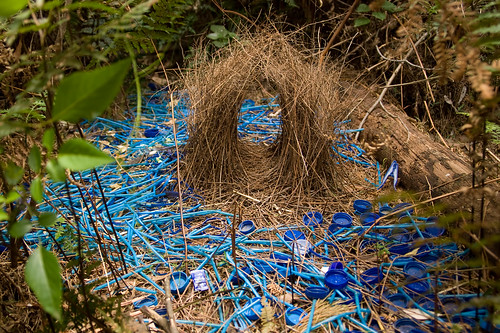Then, there’s the bowerbird. The male bowerbird devotes his life to building his bower -- a woven mess of twigs and grasses that bend, at last, into an arch. He’ll wander across the forest floor collecting materials and scavenging for ornaments that he can tuck into the wooden frame or line in a path towards the bower’s entrance. There are bowers decorated with shells, bones, feathers and lost blue bottle caps. Maybe a few berries or bits of found glass. Some birds will steal pieces from other bowers to use in their own. He’ll throw it all in, so long as it is beautiful and arranged just right for the female bowerbirds passing by.
 |
| A satin bowerbird's bower. Photo credit: barryhatton33 |
When I’m writing about ordinary subjects, it can be a challenge to make things interesting. But a topic that’s too familiar can be made new again with embellishments. So, I search for material in odd places --old textbooks, overheard conversations, notes on animal courtship. Toss a few bones and feathers into that plain, wooden bower to spice it up. These stories decorate the piece and, hopefully, draw in the reader.
When I’m writing about science, things are backwards. I start with a complex, counter-intuitive framework (DNA replication, for instance) and try to find things that will make it appealing to a lay audience. Here, I go searching for trinkets from everyday life that will make the scientific framework more approachable.
Success in penning compelling prose --about science, about anything --is limited only by how much you can notice, and then by how well you can weave the ordinary in with the extraordinary. If you’re a scientist, perhaps writing is already settled into your nature. Science is about fine-scaled observation, after all.
The physicist Michael Faraday delivered six lectures on a single, burning candle. If you challenge yourself, he said, you can make 20 observations about one candle. Start at the flame’s tip and work your way down to the pool of wax at the base until you have 30 notes, then 40, and on until the end. No surprise, Faraday was one of the most fantastic scientific communicators we’ve ever known.
But back to the bowerbird. In trying to appeal to his mate, the bowerbird spends his time arranging and then rearranging his trinkets. He never settles. Strike the shell from the twigs over here, pitch it to the side. Whatever works. The best arrangements win the mates, and the bowerbird knows it.
Rearranging things and paring down, any writer will tell you, is the hard part. The interests of the reader and the overall integrity of the piece often override the survival of your favorite lines. Sometimes, you have to remove, in one second, a sentence that struggled for days to come into joyous, perfect being because it simply does not fit anymore. “Kill all your darlings,” says Faulkner.
In science writing, there is an extra incentive to kill those darlings if it will help your clarity and accuracy. Careful, though, that you don’t strip everything down to the maddeningly accurate (things get boring quickly). For me, the excitement of science writing, the challenge of it, is the balancing act between my responsibility to factual accuracy and my responsibility to the reader, who deserves to encounter those facts in an interesting way.
The bowerbird courts his mate, and I court the reader. Either way, it's a frenzied life of arranging, rearranging, and hoping for something beautiful.

No comments:
Post a Comment